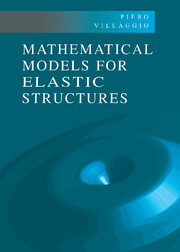Book contents
- Frontmatter
- Contents
- Preface
- Introduction
- Chapter I Basic Concepts
- Chapter II Rod Theories: Three-dimensional Approach
- Chapter III Rod Theories: Director Approach
- Chapter IV Theories of Cables
- Chapter V Theories of Membranes
- Chapter VI Theories of Plates
- Chapter VII Theories of Shells
- References
- Index of Authors Cited
- Index
Introduction
Published online by Cambridge University Press: 11 September 2009
- Frontmatter
- Contents
- Preface
- Introduction
- Chapter I Basic Concepts
- Chapter II Rod Theories: Three-dimensional Approach
- Chapter III Rod Theories: Director Approach
- Chapter IV Theories of Cables
- Chapter V Theories of Membranes
- Chapter VI Theories of Plates
- Chapter VII Theories of Shells
- References
- Index of Authors Cited
- Index
Summary
What does it mean to solve a problem in classical elasticity? The question may appear trivial, but, if we ask scholars working in the field, we receive surprisingly different answers. Let us assume, in order to make the subject more explicit, that the problem concerns the impact between two elastic bodies. For an experimental physicist solving the problem means interpreting those crucial experiments that make it possible to decide which are the important variables in the phenomenon: in this specific case, the densities and elastic moduli of the materials are important, but the temperature and atmospheric pressure, for instance, are not. A theoretical physicist will say instead that the solution consists in formulating the general equations of the problem, having inserted all the significant variables. For a mathematician it will be obvious that solving the problem means finding an existence, uniqueness, and possibly regularity, theorem for the equations of elastic impact. Yet another answer will be given by an engineer, who will require an explicit formula giving the stress components within the two bodies at each point and at each instant.
Confronted with such a variety of answers, a typical student feels disoriented, being immediately aware of the basic ambiguity in the way in which the question itself has been posed. Ludwig Wittgenstein would say in explanation that the confusion arises from the vague use of the verb “to solve.” For the same word has been used in different contexts with different meanings.
Though dissimilar, the four answers have a common characteristic. They represent four attempts at describing the same phenomenon by abstraction, setting aside the unessential details, with the purpose not merely of illustrating but also of predicting. We say that they propose four models for the elastic impact. At this point we immediately ask whether there is a rational criterion for deciding which model is preferable, provided that all satisfy the three necessary requisites of being realistic, logically coherent, and simple. It is evident that a model must not be in obvious conflict with the physical data, nor must it be self-contradictory or too complicated. However, unfortunately, there is no incontrovertible way of establishing that one model is better than another. Setting up a model means creating conceptual conditions suitable for posing a particular question about the problem.
- Type
- Chapter
- Information
- Mathematical Models for Elastic Structures , pp. 1 - 6Publisher: Cambridge University PressPrint publication year: 1997



